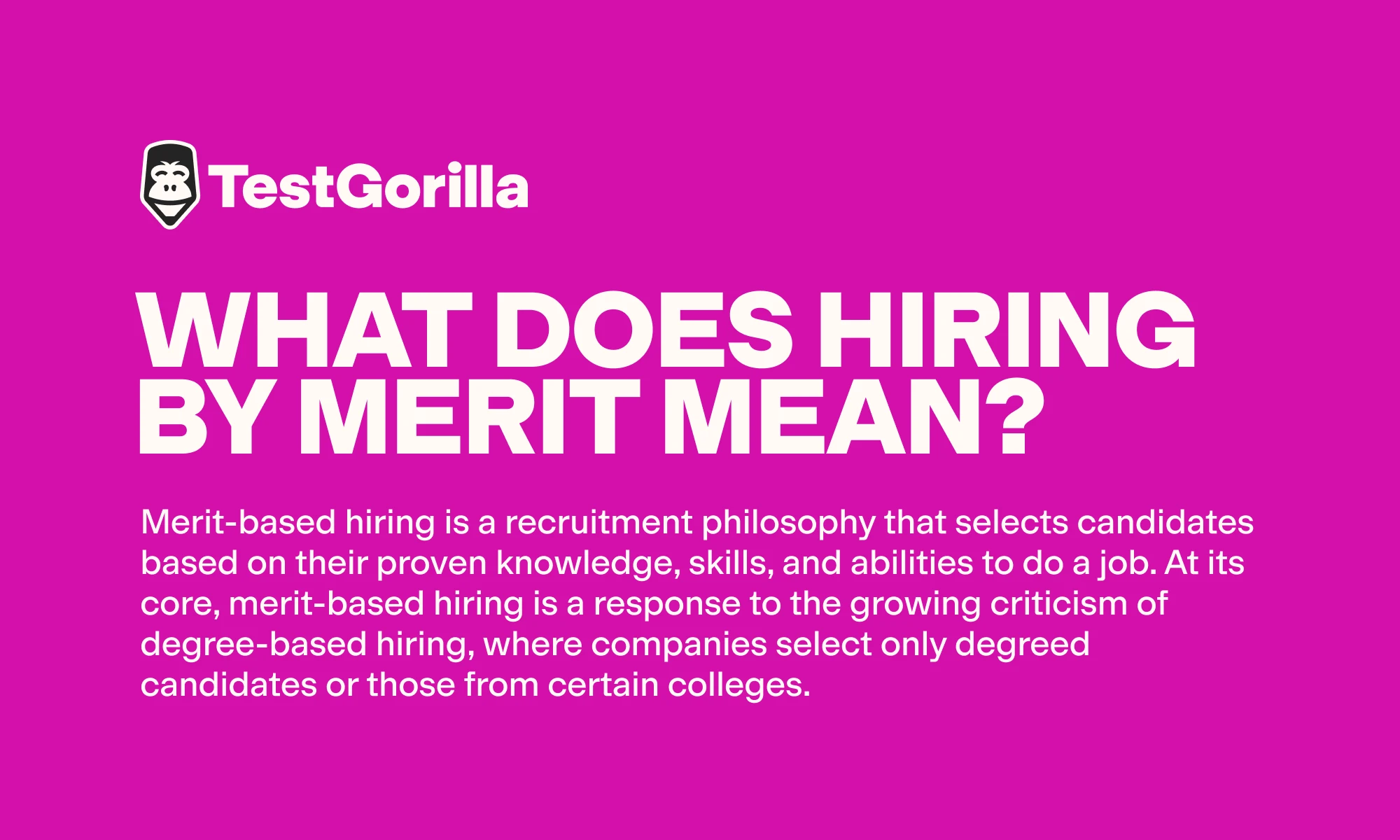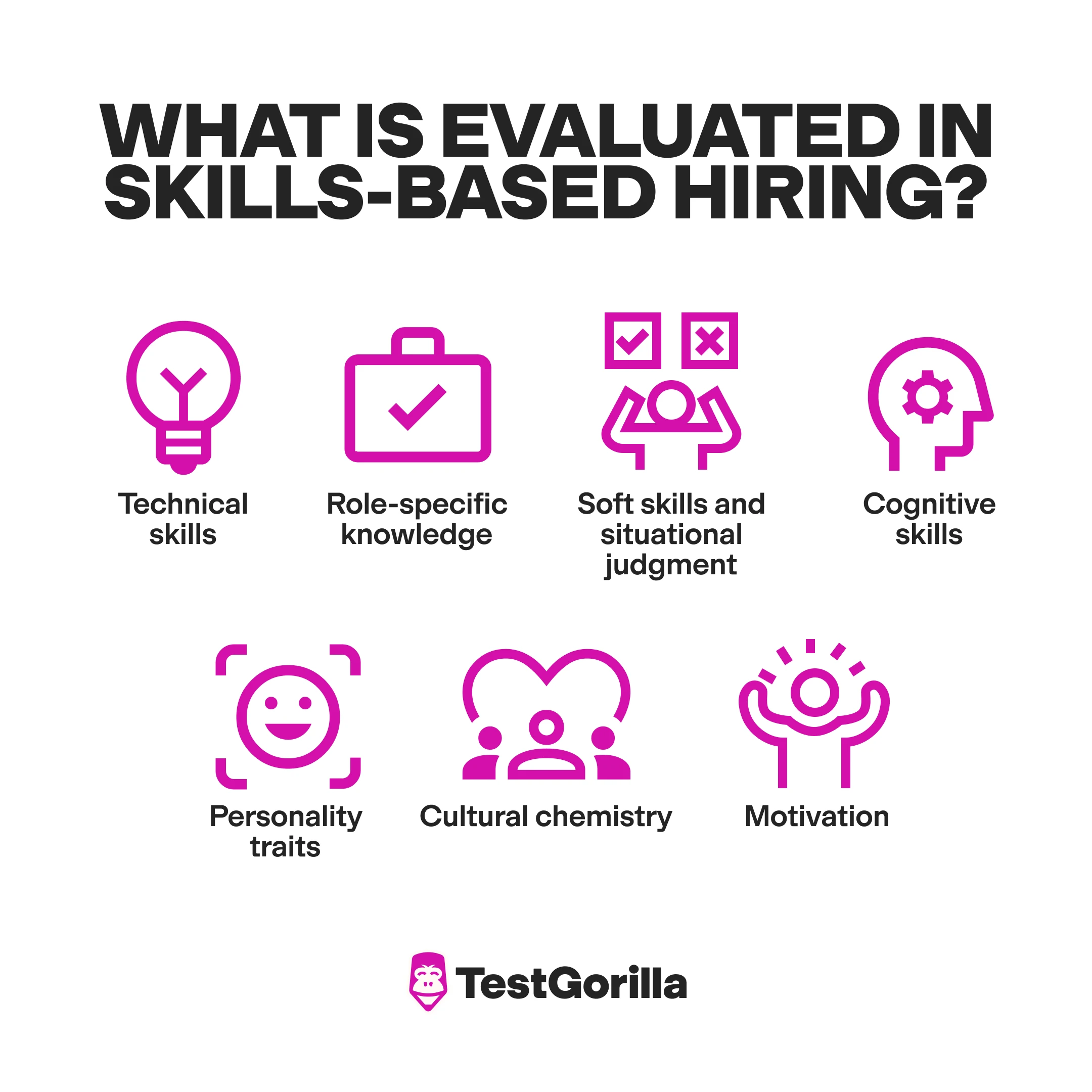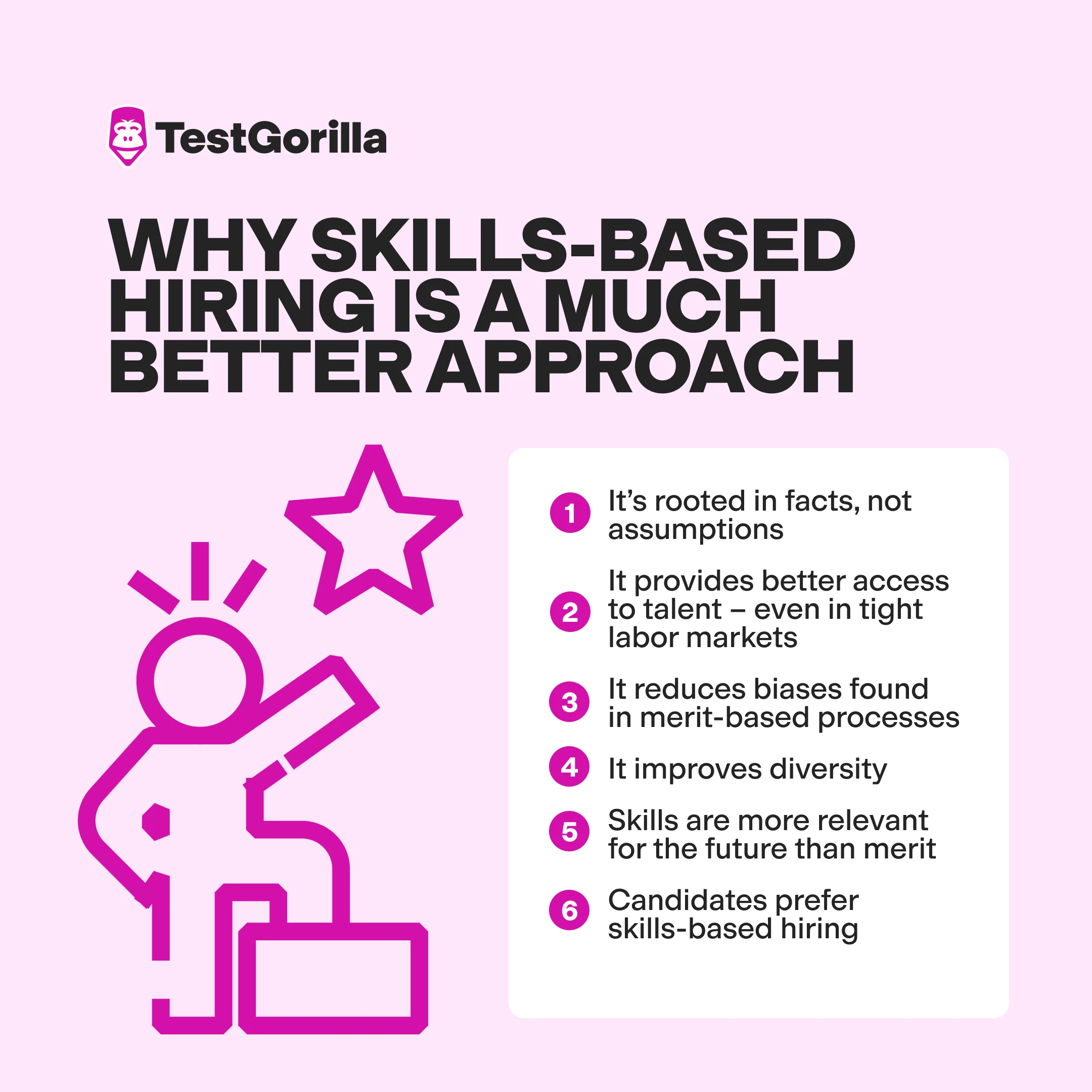Recruitment is on the brink of a complete revolution. With growing intolerance for unfair hiring and nepotism, companies are under more pressure than ever to find top candidates while still providing equal opportunities for everyone.
While many employers claim to be moving toward a fairer approach, several of them have made no tangible change in how they hire. College graduates are still snagging top jobs over those who are skilled but less privileged.
The issue is that employers are now focused on candidates’ merit – which sounds promising but doesn’t solve the problem. For a truly fair and effective process, you should be looking for skills – not merit. And, no, they’re not the same thing.
In this article, we explain the difference between hiring for skills versus merit – and discuss why skills-based hiring is the game-changer your company needs.
What does hiring by merit mean?
Merit-based hiring is a recruitment philosophy that selects candidates based on their proven knowledge, skills, and abilities to do a job. At its core, merit-based hiring is a response to the growing criticism of degree-based hiring, where companies select only degreed candidates or those from certain colleges.
Merit-based hiring doesn’t just consider degrees. It considers candidates' skills, achievements, and other factors to get a better-rounded picture of their profiles. This enables companies to base hiring decisions on more than just credentials.
What does “merit” comprise?
Let’s take a closer look at what employers assess in a merit-based approach.
1. Qualifications
This includes a candidate’s educational credentials, including degrees, certifications, diplomas, or specific training relevant to the position. The idea is to predict whether candidates have the knowledge needed for the job.
2. Work experience
Employers look at where candidates have worked before, including the companies, industries, lengths of service, designations or job titles, and daily roles and responsibilities. Here, the aim is to understand more about which types of tasks and projects applicants have first-hand experience with.
3. Hard and soft skills
Merit-based practices also use tests, case studies, and practical tasks to assess candidates' hard skills – such as programming. They do the same for soft skills like communication, problem-solving, and teamwork. This ensures that candidates are capable of doing the job well.
4. Notable achievements
This includes external awards, internal recognition such as “employee of the month,” college achievements like “dean's list,” sports-related awards, published papers, and more. Many companies use this information to assess if candidates have leadership, grit, and drive.
5. Past performance
Some employers ask for previous performance ratings, promotion timelines, or feedback from ex-managers or colleagues to indicate a candidate’s work quality, reliability, and overall work ethic.
Merit-based hiring process
This is what the end-to-end application process looks like for a merit-based hiring approach.
Job analysis: Employers identify gaps in their workforce and determine the position they need to fill.
Role description and posting: Next, they list the specific qualifications, years of experience, and skills they’re looking for. They post this job description to job boards or their company’s website or run campus hiring programs. This is also where they provide candidates with information about the job, company, and employee benefits.
Application screening: Once they receive applications, recruiters screen resumes, cover letters, and application forms to spot candidates that meet the role requirements.
Assessments: Employers often use case studies, practical tasks, online or in-person tests, and more to evaluate these candidates’ hard and soft skills.
Interviews: Shortlisted candidates then get invites for interviews. This process often involves multiple rounds and can include an initial phone call, a technical round, a motivational interview, a competency-based session, and even a culture-fit round.
Reference checks: Before making a final decision, most employers conduct reference checks by contacting candidates’ managers, colleagues, mentors, or academic contacts. This is to verify past performance and behavior.
Decision-making: All stakeholders involved in the process come together to choose their top candidate. This decision is usually based on candidates’ resumes, assessment scores, and interview feedback.
Job offer: The next steps involve issuing a job offer, negotiating terms, setting a start date, and signing the contract.
Background checks: Employers often conduct a background check to ensure that candidates have been truthful about their credentials, experiences, right to work in the country, and other aspects of their backgrounds.
Onboarding: In the final step, candidates join the company and go through an onboarding process to meet the team, learn about the company culture, and start training for their new role.
What is a skills-based approach?
Skills-based hiring is a recruitment approach that selects candidates based on how their existing skills and abilities match with the needs of a job.
While the term “skills-based hiring” is often used interchangeably with “merit-based hiring” and there’s some overlap, they’re actually different. Skills-based hiring takes educational qualifications and past experiences out of the equation – and adds a few factors that aren’t typically looked at in a merit-based approach.
What do “skills” comprise?
Let’s dive into what you evaluate in skills-based hiring.
1. Technical skills
This includes the specific hard skills necessary for a job – for example, financial modeling is an essential skill for financial analysts. Candidates’ technical skills determine if they can perform their daily duties effectively.
2. Role-specific knowledge
Employers need to know if a candidate has a strong grasp of the technical terms, processes, and standards required in a role. This covers industry-related information such as labor laws for HR roles or health and safety knowledge for restaurant jobs. It also includes knowledge about a company’s market, customer base, or offering.
3. Soft skills and situational judgment
In addition to hard skills, employers must check that candidates have the right soft skills and decision-making abilities to succeed in their jobs. For example, when assessing admin assistants, you’d check if they have great organization, time management, interpersonal skills, and the ability to work under pressure.
4. Cognitive skills
This set of transferable skills looks at how candidates think and process information.
For instance, numerical reasoning refers to the ability to work with numbers, reading comprehension focuses on how they interpret information and make decisions, and problem-solving and critical-thinking are about how individuals define and deal with problems.
5. Personality traits
Employers need to ensure they hire someone who has the right traits and behaviors for the job and will mesh well with their team members. A good salesperson, for example, needs to be patient, polished, and persuasive with customers. But they’ll also need to show they’re collaborative and can work with marketing and product teams effectively.
6. Cultural chemistry
This looks at how well a candidate aligns with a company’s culture, values, and ethics – helping employers to check that applicants can both contribute to and enhance the workplace.
Let’s say a company has a fail-fast culture – meaning they’re willing to experiment, learn quickly from their mistakes, and try again. This employer will need someone comfortable with failure, rather than someone who struggles with it.
7. Motivation
Employers must understand what makes their candidates tick, both in terms of their passion for an industry or role and their expectations around pay, benefits, and career development.
Skills-based hiring process
Here’s what an end-to-end process looks like for skills-based hiring.
Skills analysis: Employers regularly work with talent acquisition to review their skills ontology – the company’s existing skill sets and how they stack up against company goals. This way, they can identify any skill gaps that must be addressed.
Skills-based job descriptions and posting: Once the necessary skills have been identified, employers write a role description that focuses on the skills and competencies needed for the role rather than listing educational degrees or years of experience. These job descriptions are then posted to traditional and newer skills-based job boards (like our job board).
Skills assessments: Every applicant is put through simulations, practical tasks, or most commonly – online skills-based talent assessments. These screen them based on multiple measures, including their hard and soft skills, situational judgment, cognitive abilities, personality traits, cultural contributions, and more.
Behavioral interviews: Shortlisted candidates are invited to attend in-person or virtual interviews with a fixed set of questions designed to dive deeper into their behaviors and real-world experiences.
Decision-making: Recruiters pick the best candidate by looking at their talent assessment scores and interview feedback.
Job offer: Employers create a job offer based on what they’ve learned about the candidate’s motivation and expectations, run through any last-minute negotiations, and have both parties sign the paperwork.
Background checks: This is usually to check for honesty in responses rather than label skilled- candidates as less worthy of a job due to any problems from the past. True skills-based hiring puts the past aside to focus on a candidate’s current skills and traits.
Onboarding: New hires – who are already familiar with the company’s culture – are introduced to their teams and workplaces.
The best insights on HR and recruitment, delivered to your inbox.
Biweekly updates. No spam. Unsubscribe any time.
Why skills-based hiring is a much better approach
Merit-based hiring and skills-based hiring both try to accomplish the same thing – selecting quality talent in a fair way.
But is one better than the other?
We believe skills-based hiring is, by far, the superior approach.
Here’s why.
1. It’s rooted in facts, not assumptions
In a merit-based approach, you review candidates’ resumes, cover letters, and application forms as the first step of the application process – even before you put them through skills tests.
We recently surveyed 1,500 employers and found that 87% of them have difficulty trusting the accuracy of resumes, ranking applicants, or determining applicants’ true skills.
If you can’t really verify candidates’ skills and abilities, how are you making decisions about who to progress to the next round? Screening candidates based on a piece of paper puts you at risk of progressing unskilled candidates or rejecting top talent before they’ve had a chance to prove themselves.
A skills-based process, on the other hand, typically uses talent assessments as the first step of the application process. These help you see how candidates score on the skills, traits, and cognitive abilities needed for your role.
Screening candidates using hard, relevant data rather than assumptions enables you to make better predictions about their future job performance and hire the best ones. In fact, our study showed that 88% of employers using skills-based hiring found it reduced mis-hires.
2. It provides better access to talent – even in tight labor markets
In a recent post, Michael Feroli, J.P. Morgan’s Chief U.S. Economist, explained that the last few years have seen tight labor markets characterized by low unemployment and fewer workers available to fill jobs. “The labor market is now becoming less tight – not by a lot, though,” Feroli said.
As companies deal with a lack of skilled workers to fill open roles, some merit-based practices make matters worse by pointlessly limiting your talent pool. For example:
A recent report by the Burning Glass Institute showed that despite removing degree requirements from job descriptions, companies haven’t changed the way they hire. They’re still giving more chances to college grads – and likely eliminating skilled candidates without degrees.
Asking for specific years of experience can also lead to losing highly skilled and capable candidates with fewer years of experience.
Lengthy application forms, cover letter requirements, and a longer assessment process can deter candidates from applying for jobs.
Needlessly narrowing your talent pool like this prevents you from accessing top talent.
Skills-based hiring, however, focuses primarily on individuals’ skills and experience by completely eliminating the need for qualifications or years of experience. This opens the door to both college grads and STARs – those skilled through alternative routes.
Further, since a skills-based hiring approach involves a shorter hiring process and, therefore, better candidate experience, more candidates are likely to apply with this approach. And our research showed that 92% of employers felt skills-based hiring made it easier to identify talent.
3. It reduces biases found in merit-based processes
Again: relying on resumes means you’re screening candidates based on information you haven’t yet verified. But did you know that reading resumes and cover letters in merit-based hiring also makes it harder to avoid unconscious biases? Here are some examples:
Confirmation bias: This is when you create an initial impression of a candidate from a resume – for instance, based on their past employment at a big-name company. Then, you spend the rest of the application process looking at them through the same lens to “confirm” your initial assessment – regardless of their performance in skills assessments or interviews.
Halo bias: In this bias, one positive characteristic of a candidate – let’s say, their Ivy League education – influences your overall view and makes you believe they’re great in every aspect. This often overshadows their areas of development.
Similarity bias: Here, you tend to gravitate toward candidates who’ve got something in common with you. For example, maybe they’ve got the same alma mater or a similar interest in hobbies listed on their resumes.
Merit-based hiring also emphasizes reference checks – where you contact past employers to vet candidates. People providing references may provide subjective opinions about candidates, including extra positive or negative ones.
With no resumes, cover letters, or reference checks in a truly skills-based process, decisions are made using objective evidence and are less prone to biases.
4. It improves diversity (while the lines between merit and privilege can be blurry)
Writing skills-based job descriptions and using talent assessments at the start of an application process opens the door to a much wider pool of talent and reduces biases.
Ultimately, this means skills-based hiring increases the likelihood of capturing and hiring diverse talent. We actually found that 84% of employers using skills-based hiring saw a positive impact, and 22.5% reported a very positive impact on diversity.
Also, 75% of Black candidates and 73% of Asian and Arab candidates accessed new jobs due to skills-based assessments.
While merit-based hiring aims to improve diversity, a recent study by the American Psychological Association explained that merit-based selection processes are actually unfair. The study’s authors write:
In reality, inequality and merit-based decisions are deeply intertwined… Socioeconomic advantages and disadvantages early in life can have profound influences on educational achievement, test scores, work experiences, and more...As a result, the qualifications that form the basis of “meritocratic” selection processes partially reflect unequal starting points.
In sum, people with socio-economic disparities and even racial minorities likely haven’t had access to the same opportunities as those more privileged.
For example, one 2023 study showed that only 34% of Black Americans had associate degrees or more compared to 50% of White Americans.
And the problem doesn’t stop at gender, ethnicity, or socio-economic status. Employers who screen people’s backgrounds on their application forms may rule out refugees or those with minor criminal offenses – even if they have the right skills.
Merit-based hiring often eliminates diverse candidates early in the process, while skills-based hiring gives them a fair opportunity to showcase their abilities first.
5. Skills are more relevant for the future than merit
The World Economic Forum’s Future of Jobs report suggests that 44% of today’s skills will be disrupted or obsolete in the next five years. With the speed of innovation and the rise of AI, the skills employers need keep changing – and people’s past achievements, degrees, and previous experiences are being rendered useless.
That’s why employers are increasingly prioritizing cognitive skills and personality traits when looking for top candidates. This includes analytical thinking, problem-solving, tech-savviness, resilience, adaptability, agility, motivation, and self-awareness.
Unlike merit-based hiring which primarily focuses on a person’s merit, skills-based assessments account for their cognitive abilities, personality traits, and even cultural chemistry.
This way, you’re hiring people with a strong set of transferable skills and traits who can pivot as the landscape changes.
6. Candidates prefer skills-based hiring
Our research showed that candidates actually prefer a hiring process that focuses on skills over education and experience. We found that:
56% of them preferred application processes with skills-based assessments
86% of them felt they were more likely to secure their dream job when given a chance to prove their skills
66% of them said they’ve gained access to new job opportunities through skills-based assessments
38% of skills-based hires said they were very happy in their roles, compared to 28% of experience-based hires
End paper-thin hiring with a skills-based approach
Many companies believe a merit-based hiring process solves the issues that come with degree-based hiring. Some even believe their merit-based approaches count as skills-based hiring.
But despite good intentions, a merit-based approach focuses heavily on a person’s past education, experiences, and achievements, which are influenced by factors like race, gender, and socioeconomic status. Moreover, resumes and reference checks add bias and subjectivity to the selection process.
In contrast, skills-based hiring is the ultimate way to hire. A true skills-based process uses talent assessments with a platform like TestGorilla at the start of the hiring process.
This puts the focus on candidates’ existing skills, gives everyone fair and equal opportunities, and helps you make evidence-based decisions to hire only the best talent in the fairest way possible.
Related posts
You've scrolled this far
Why not try TestGorilla for free, and see what happens when you put skills first.

















